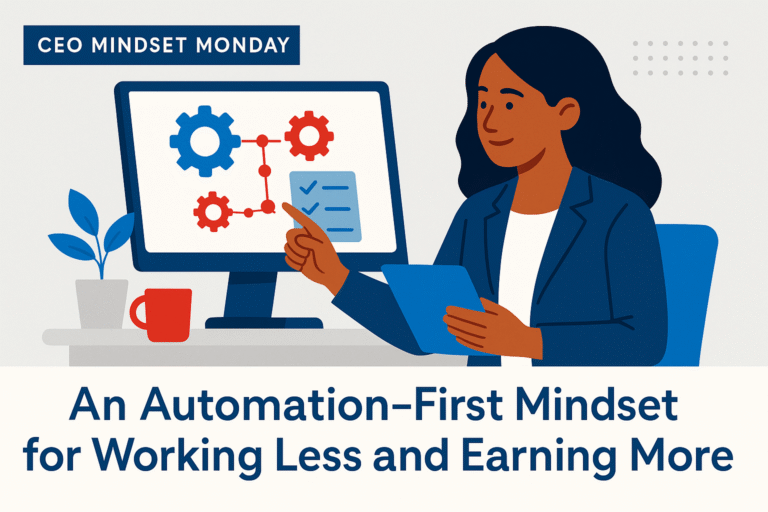Financial Freedom Friday
“Save time and make money” isn’t just a catchy phrase—it’s a design choice. If you’re building a business while holding a full-time job, you don’t have unlimited hours. You have pockets of focus, a few windows each week, and the determination to use them well. That’s enough. The path to higher earnings isn’t about squeezing more minutes into your calendar; it’s about rethinking how value gets created so your time multiplies.
If you’ve tried running a business before, you know how easy it is to get trapped in the cycle of saying yes to everything—joining groups, building offers, chasing opportunities—only to end up drained, behind financially, and questioning whether you can keep going. I fell into that same cycle during the early years of Backbone America. The more I pushed, the more I realized I was building something that consumed me rather than supported me. That cycle only breaks when you stop asking, “How can I get more done?” and start asking, “How can I design this so it runs efficiently, earns consistently, and doesn’t demand constant hands-on attention?”
That shift is the key to creating a business that works for you instead of the other way around. The answer lies in leverage: narrowing to high-impact work, automating repeatable steps, and creating offers that scale without consuming every free moment.
This is your practical walkthrough. By the end, you’ll know how to identify the few activities that drive profit, replace repetitive tasks with systems, and choose revenue models that stop punishing you for being one person. No fluff. No hustle theater. Just a clear plan to save time and make money on purpose.
The Old Assumption: More Hours = More Income
 You’ve probably been told that if you want to make more money, you have to work more hours…. the hustle mentality. That might work in an hourly job, but it falls apart when you’re building a business on limited bandwidth. You only have so much time and energy to give before you hit the terminal point.
You’ve probably been told that if you want to make more money, you have to work more hours…. the hustle mentality. That might work in an hourly job, but it falls apart when you’re building a business on limited bandwidth. You only have so much time and energy to give before you hit the terminal point.
And think about this. Eventually, more hours start producing worse results: slower decisions, sloppy execution, and missed opportunities because you’re too tired to notice them. If you fill every evening and weekend with extra work, you might see progress at first. But burnout hits quickly, and quality slips.
You don’t need a research paper to know this, but studies confirm it—past a certain point, productivity doesn’t rise proportionally with hours, and quality often declines.
Picture two real scenarios:
Service business: A consultant stacks back-to-back Zoom calls from 7–10 p.m. after work. The first call is sharp; by the third, notes are messy, follow-up slips, and the client experience dips. The calendar is full, but the pipeline suffers.
Product business: A course creator spends late nights editing videos and answering ad-hoc student emails. They release more lessons, but have no time to improve onboarding or refine the sales page—so revenue plateaus despite the effort.
Let’s put this Into dollars. If that consultant charges $200/hour and the third call of the night results in a missed follow-up, that’s not just lost momentum—it’s potentially $1,000+ in lifetime client value gone simply because there wasn’t enough energy left to close the deal.
If your plan relies on “finding more hours,” you’ll eventually hit that wall. Also, if it relies on leverage, you create a ceiling that’s much higher than your week.
What Actually Moves the Needle (And What Doesn’t)
To save time and make money, you need to be clear about what’s truly moving your business forward. The difference between busy and profitable isn’t always obvious, but there’s a simple filter you can use:
If you stop doing this for two weeks, will revenue dip? If not, it’s not core.
Does this activity create assets you can use again? Templates, emails, checklists, videos—these are multipliers.
Would a customer pay for the outcome of this task? If the answer’s yes, it’s closer to revenue.
When I applied these questions to my own calendar, I realized how much time I was losing to “nice to have” work. In my first run at Backbone America, that meant admin work, over-customizing projects, and networking that didn’t connect me to my target audience. The real moneymakers—sales, onboarding improvements, customer follow-up—were getting pushed aside.
Quick exercise: Label every block in your calendar A (directly tied to revenue in the next 60 days), B (builds assets you’ll reuse), or C (nice to have). Expand A and B. Compress C. This isn’t about becoming a machine—it’s about using your time like an investor uses capital.
If you can reclaim even two hours a week from C-level tasks and shift them to A-level activities that bring in $500 in client work, that’s $4,000 more in revenue over six months—without working a single extra hour.
Design for Leverage: Systems Beat Willpower
If you’ve been relying on sheer willpower to grow your business, you’ve already felt how inconsistent it is. Some weeks you’re on fire; others, you’re crawling to the finish. Systems don’t have that problem—they work the same whether you’re feeling motivated or not.
Leverage shows up in three places:
Focus (fewer, more valuable activities)
Systems (automation and templates)
Offers (scalable delivery)
When I transitioned into my role as a Business Process Automation Engineer, I saw how small, strategic systems could save entire teams hundreds of hours a year. Applying those same principles to Backbone America changed how I worked, where I focused my resources.
Start by looking at the work you already do every week:
Lead capture & follow-up: Every missed follow-up is a potential client lost. By automating your welcome emails and nurture sequence, you keep warm leads engaged—turning more inquiries into paying clients without extra hours.
Scheduling: Eliminate the back-and-forth by using a booking tool that connects to your calendar.
Onboarding: Send clients an automated “start here” message, access links, a kickoff form, and a timeline—without you having to remember.
Delivery: Use templates and pre-recorded resources to handle predictable parts so your live time is reserved for expertise.
Offboarding & reviews: Automate requests for feedback and invitations to the next step.
If your average onboarding takes 60 minutes and you bring in four clients a month, that’s four hours back. At $150/hour, you’ve freed $600 worth of your time—every single month—by automating one process.
Mapping these steps in my own business revealed just how much time I was wasting on tasks that could run themselves. Fixing those bottlenecks created an immediate return in both time and energy.
Automation That Pays for Itself
Here are three automation categories that typically return the most time in the first month. Choose one per week and implement it without overloading yourself:
Marketing & Nurture
Trigger: New subscriber joins your list.
Flow: Deliver the promised freebie or welcome note → 2–4 short educational emails → invitation to take a small next step.
Why it pays: Every new subscriber hears from you automatically, even if you’re offline.Sales Readiness
Trigger: Prospect clicks your pricing page or views your offer multiple times.
Flow: Tag the lead → send a value-driven follow-up → offer a short call or resource.
Why it pays: Warm interest doesn’t go cold while you’re sleeping.Client Onboarding
Trigger: Payment received or proposal accepted.
Flow: Auto-send kickoff email, intake form, and a link to book the first session; grant access to shared folders and a status hub.
Why it pays: You create a smooth, professional start without scrambling.
In my own business, automating onboarding alone saves me an hour per client. That’s not just time back—it’s mental space reclaimed. Even more, at my current rates, saving an hour per onboarding means the automation pays for itself after just two clients—and keeps paying dividends long after.
Build Offers That Don’t Punish Your Calendar
If all your income is tied to one-to-one work, your calendar becomes the limit on your income. Adding scalable elements allows you to keep serving clients while increasing earning potential.
Scalable components might include:
Productized services with fixed scope and reusable assets
Templates or toolkits based on your proven processes
Workshops or mini-courses that live on after the live delivery
Light-touch memberships for ongoing support

In my first years running Backbone America, I made everything custom. The work was rewarding, but it left no room for growth. This time around, I started packaging the parts of my process I used repeatedly. I gained back time without losing quality—and clients appreciated the clarity of knowing exactly what to expect.
If you can reduce delivery time from 10 hours to 6 without lowering your price, you’ve just increased your effective hourly rate by 66%—which, over 10 projects, is the equivalent of adding four extra paid projects to your year.
Protect Your Time Like an Asset
Time is your most valuable business resource, and it’s finite. Without boundaries, you’ll fill it with low-value work that leaves you exhausted and no closer to your goals.
Simple guardrails that work for me that you might consider:
Office hours for your business: Pick two weeknights and one weekend block. Protect them like paid appointments.
No-meeting days: Block off one evening for deep work—writing, asset creation, or system improvements.
Communication windows: Check messages at set times to avoid constant interruptions.
Batch repetitive tasks: Handle similar work in one session to reduce context-switching.
Default to templates: If you do it twice, template it. If you send it twice, automate it.
Once I began guarding my calendar the way some people guard their bank account, my stress decreased and I found myself being more productive when it mattered. The thing is, the less I treated time as disposable, the more strategic my business decisions became.
The Freedom Checkpoint: Focus, Systems, and Scalable Assets
If you want your business to give you both time and money freedom, you need three elements working together:
Focus – Spending most of your work time on activities that directly generate revenue or build long-term assets.
Systems – Having repeatable, automated processes that run without you doing each step manually.
Scalable Assets – Offers, resources, or products that can be sold or delivered to many people without adding more hours to your workload.
Here’s a quick self-check. For each area, rate yourself from 1–5:
| Area | 1–2 (Needs Work) | 3–4 (Solid) | 5 (Strong) |
|---|---|---|---|
| Focus | Time split between busywork and revenue tasks | Revenue work takes up more time than admin | Almost all time is spent on high-value work |
| Systems | Most work done manually | Some processes automated or templated | Most recurring work runs without you |
| Scalable Assets | All income is tied to live delivery | Some repeatable offers in place | Multiple offers earn without extra hours |
How to Use It:
Circle the lowest score.
Make that your priority for the next 30 days.
Even one-point improvements in your weakest area can free hours each week and increase income without extra effort.
Example:
I base my products off a 10-hour workweek, taking into account that most individuals I serve have full-time jobs. Given that, you might start with 7 hours spent delivering client work with 3 being eaten by admin—writing custom proposals, sending onboarding emails, and manually setting up projects. After creating a reusable proposal template, automating onboarding, and turning one common service into a fixed-scope package, your delivery might drop to 5 hours a week and admin to 1 hour. That frees up 4 extra hours every week—16 hours a month. That means for your business, you’ve added an equivalent of two full workdays each month without touching evenings or weekends.
If those 16 reclaimed hours a month are billed at even $100/hour, you’ve added $1,600/month to your earning capacity—or nearly $20,000 a year—without extending your workweek.
Money-Smart Thinking for Side-Builders
To save time and make money, you need financial habits that match your business model—and the discipline to act on them even when your time and energy are limited.
Start with these money-minded principles:
Treat personal funds as owner’s equity, not income. Assign them to building assets—like automation tools, reusable templates, or course platforms—not just covering costs.
Price for reality. If a price point demands too much of your time to deliver, it’s too low to sustain. Raise it, package differently, or add scalable components.
Track your time. Every hour you spend is either a cost or an investment. You’ll quickly see which activities deserve to stay and which need to go.
Focus on compounding moves. Choose tasks that create reusable assets—templates, recorded trainings, checklists—rather than one-off wins that vanish after delivery.

When you apply these rules consistently, you’ll start to see time and money working together instead of competing.
That’s where energy management comes in.
On nights when you’re running on fumes, don’t push for the big projects. Pick one five-minute improvement—a reusable email, a scheduled post, a better file structure. Each tiny upgrade frees time or increases value, stacking small wins that pay off over months.
On weekends or high-energy days, put your hours into one step that directly increases earning power without increasing hours: record a tutorial you can sell, build a checklist to speed delivery, or create a “getting started” guide that makes onboarding faster. Over time, these choices create an upward cycle—less effort, more value, better margins.
Common Traps (And Better Alternatives)
Even with the best intentions, it’s easy to fall into patterns that slow your progress and limit your earning potential. I’ve seen these play out repeatedly in my own business and in conversations with other entrepreneurs. They’re not signs of failure—they’re just friction points you can fix.
Trap: Building three offers at once.
Better: Start with one offer that meets a clear, proven need. It’s easier to refine, market, and scale one winner than to juggle three half-built ideas.Trap: Custom everything.
Better: Standardize 80%, customize 20%. The core process should be predictable and repeatable; the custom touch should enhance, not derail, your delivery timeline.Trap: Waiting to automate until you’re “ready.”
Better: Automate tiny steps now. Even one automated email or templated proposal can save hours over the course of a month.Trap: Viewing your job as the enemy.
Better: Use it to fund your business growth. Your paycheck can be the investment capital that buys you tools, training, and breathing room.
Small shifts like these free both time and headspace—resources you can reinvest into the activities that actually grow your business.
Your Next Right Step
Pick one bottleneck to fix this month. Automate a repetitive step, productize one service, or block time for asset creation.
Every small change you make in the right direction builds momentum. That’s how you save time and make money without sacrificing your health, family, or career.
If you want practical emails that help you save time and make money without busywork, join my mailing list. I send high-value, transformative insights—not recycled tips or hype. You’ll get the kind of breakdowns that help you act in under an hour. Sign up here.






